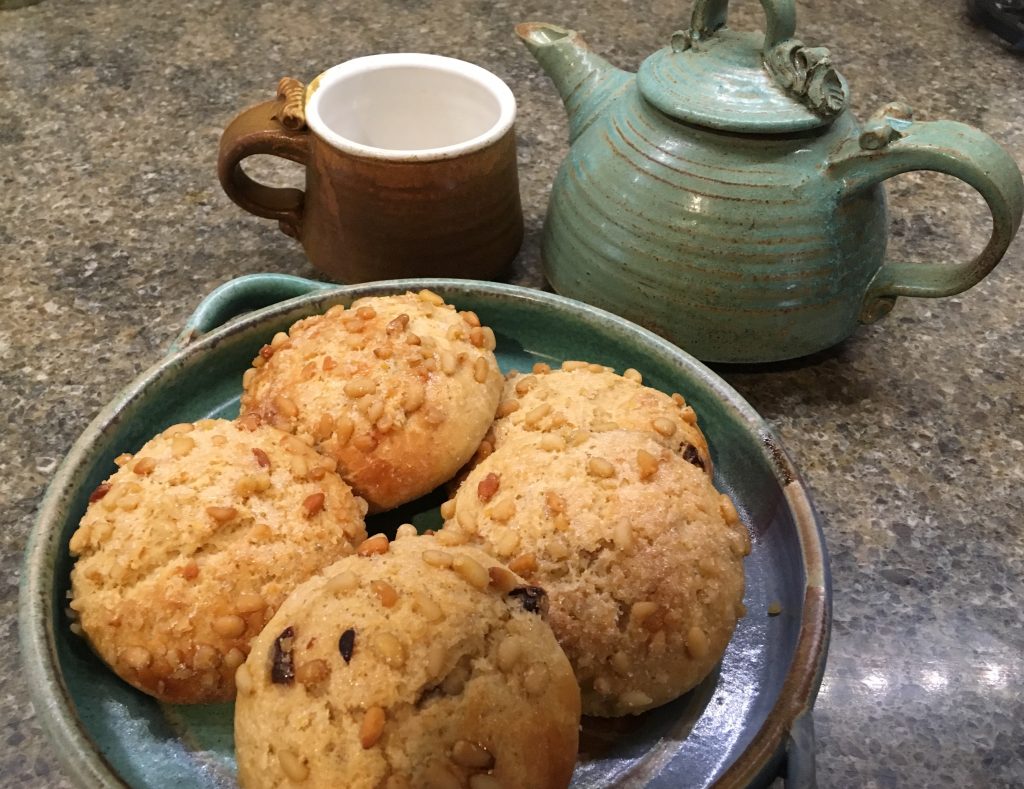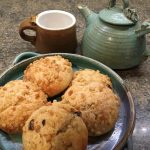
So… I was a bread baker wannabe born to a couple of hot roll mix mavens. My grandmother’s delicious “homemade” raisin bread was actually hot roll mix with added sugar and raisins, while my Mom’s “Super Sandwich Bread” was hot roll mix with raisins, grated carrots, sunflower seeds, sharp cheddar and bacon bits. The two of them certainly kept their semi-homemade recipes true to form-Grandma’s was simple sweetness and Mom’s was, in comparison, a health bomb. Not my personal favorite health bomb…
We had a few family recipes passed down from prior generations, but none of them were really bread, even for the holidays. Mom did bake a treasured almond roll for breakfast, which is still our tradition, but it was adapted from a then recent recipe called Starlight Sugar Crisps, still available on many sites online. (https://www.justapinch.com/recipes/dessert/cookies/starlight-sugar-crisps.html ) But I longed for beautiful coffee rings, savarins, braided and swirled breads. I saw it as my job to pick up the cultural bread slack around the place. Armed with my treasured bread book, I made my best attempts at baking complex ethnic breads. Mind you, I had no connection to these ethnicities, no passing-the-skills-down from generation to generation. My family is primarily English and Irish, with a bit of German thrown in (or so I’ve been told), but my ancestors came eons ago, apparently without any prized European bread recipes in hand. Also, what I didn’t know at the time was that my beloved bread book (yes, I still have it!) was written for Americans. Easier methods, more of an American product.
After leaving the farm, I seldom made bread. Busy with college, first jobs, grad school and then my own family, bread was an afterthought. We purchased it at the grocery store like all sensible Americans. A massive metamorphosis occurred when my husband, our two young children, and I took a trip to Italy, where my husband had spent his early childhood years. While commercially produced bread had stolen the market there as well, a small artisan bread movement was underway and I discovered seriously good bread. The kind that one really should be eating if one is eating bread. The kind that takes at least 24 hours from start to finish, using pre-ferments or natural yeast leavens. The kind of bread with a soft but chewy interior laced with holes, all concealed inside a heavenly crisp crust. I overdosed on this stuff for almost three weeks, wondering how I would ever learn to make it at home. Because there was no question, if I couldn’t buy it, I would have to learn to make it. I was not going to waste my calories on lousy factory made bread for even one more day.
Which was not true, of course, because first I had to locate a book that actually took the place of an Italian grandmother. I found such books while still in Italy! Written in Italian… have I mentioned that I don’t read Italian? A bit of research on my part yielded Carol Field’s amazing book, The Italian Baker. (https://www.amazon.com/Italian-Baker-Revised-Countryside-Its…/dp/1607741067) In English. Mercifully, Carol had completed my journey by spending time in bakeries across Italy, along the way writing a beautiful book, which replaced the Italian grandmother. Country loaves, ciabatta, focaccia, sweet rolls-I learned to make them all. Then, within a few years, the artisan bread movement had arrived in the states, and I could buy such bread locally. But I continued to bake it for special occasions.
These days, being retired, I make the great majority of the bread we consume at about half the cost of the artisanal loaf. I’m mighty glad that artisanal loaf is available though, because every now and again I just want to go out and buy it.
I don’t mess around with my daily bread recipe too much. Sourdough spelt whole wheat. But I am now the proud owner of multiple bread books by well established artisan bakers, and have learned a great deal about the science of bread making. When I play with bread recipes, it may take several attempts, but I know which ingredients to put where for my desired result. I thoroughly enjoy developing my own recipes from classic dough templates. Today’s morning bun is a cross between an English hot cross bun and a Roman bun. Typically eaten around the Lenten/Easter season, the English filled them with raisins and the Romans stuffed them with whipped cream. My version takes a U-turn to intersect with the delectable flavors of panettone, yet another Italian bread. My signature almond paste, fiori di sicilia (orange and vanilla flavoring) and yes, brandy to take it over the top. This is a rich roll, not as sweet as most morning buns, but definitely one of my favorites. You won’t find it, even in a European kitchen, but you can make it in your own!
About the hot roll mix…
When Mom moved into a retirement residence, she no longer had the equipment or ability to bake. But she still liked to eat. And yes, she still loved Super Sandwich Bread. Lucky for me the store still carried that cardboard box of premixed roll ingredients!
Panettone Morning Buns
Ingredients
- Sponge:
- ½ cup warm water
- 1 envelope 2 ¼ teaspoons instant yeast
- 2-½ tablespoons sugar
- 2 eggs plus 1 egg yolk
- 1 ¼ cups sprouted whole wheat or white whole-wheat flour
- Dough:
- 2 ounces almond paste
- 2 tablespoons brandy
- ¾ teaspoon fiori de sicilia or ½ teaspoon vanilla plus 1-teaspoon orange zest
- 1 cup all purpose flour
- ¼ cup plus 2 tablespoons almond flour
- ½ teaspoon salt
- 1/3 cup butter softened and cut into bits
- 2 tablespoons finely diced candied orange peel
- ¼ cup tart dried cherries diced
- 2 tablespoons sugar
- ¼ cup lightly chopped pine nuts
Instructions
- Mix all sponge ingredients together thoroughly in large mixer bowl. Cover and let rest for 45 minutes.
- To the sponge, add the almond paste, brandy, extract, flours and salt. Beat together thoroughly, then add the butter and blend until smooth dough forms. Stir in the candied orange peel and cherries. The dough will be soft. If using a stand mixer, switch to the dough hook and scoop the dough from the bowl edges into the center of the bowl. Knead for 3 minutes. Alternately, scoop the dough out of the bowl onto a lightly floured surface and roll to coat lightly with flour. Knead until dough is smooth. Place in a bowl lightly sprayed with cooking spray, then spray the top of the dough to prevent drying out. Cover and let rise until puffy, 1 to 1 ½ hours.
- Turn the dough out onto lightly floured surface and pat into a ball. Divide the dough into 12 even pieces and round each into a ball. Combine the remaining sugar with pine nuts. Dip the top of each bun into the nut and sugar mixture. Place on baking sheet either lightly greased or covered with parchment. Cover loosely and allow to rise until puffy, around 1 hour. Preheat oven to 350 degrees F.
- Bake the buns for 25 to 30 minutes, until lightly browned. Remove to cooling rack.


So glad to see this! I was wondering if you were still blogging. I love panatonne and bet this would taste great.
PS. 7″ inches of snow so far today and it is still coming down. We are hoping to head for FL in the A.M. May have to wait a day.
Crystal
Nice writings and recipe! Enjoyed both! Just wish I could eat the bread!